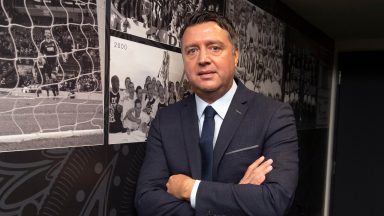The Scottish Football Association has published a report looking at the reasons behind a lack of youth development in the SPFL and the issues it causes clubs throughout the country.
It found that factors such as lack of strategy at boardroom level and a gap between academies and first teams are having a negative effect on the number of players aged between 16 and 21 making an impact, leaving Scotland behind other comparable nations.
Commissioned by the Professional Game Board last year, the review makes recommendations on how to improve the progression of talented players in the key ‘transition’ stage of 16-21.
The findings of the report, overseen by the SFA’s Chief Football Officer Andy Gould, were released on Wednesday.
It was compiled based on a range of existing global player data, comparator case studies and extensive interviews with players, coaches, chief executives, sporting directors and heads of academy across Scottish football.
It was found that Scotland had fewer players playing in European competitions last season than comparable sized and smaller nations including Albania, Iceland and Montenegro.
The report also says that widely held beliefs that the size of the leagues, lack of resources, pressure from fans and short-lived tenures of managers caused the issues within the transition phase were wrong and that those factors don’t play a significant part.
It says that the issues can instead be narrowed down to three key factors of the gap between club academies and first teams, lack of strategy at board level and the youth development phase.
There is also a belief among Scottish clubs that playing youngsters can have an overall negative impact on short-term results, but the report has found this to be false and in-fact the findings suggest that the opposite is true.
It says that the majority of teams who consistently overachieve both domestically and in European competition do so based on a strategy centred around having a top-level academy and developing their own talent.
And on financial matters, the research found that other comparable countries have focused on the model of developing younger talent both because it reduces the cost of first team salaries, and because it helps develop a player trading model which is shown to be the biggest opportunity to increase revenues as a club.
However, Scottish clubs in general still tend to focus more on issues like matchday revenue or TV distribution, which leaves them behind in the global marketplace.
Recommendations on how to fix the issue include: a cooperation system which would see increased freedom of movement of young players outwith the transfer window, innovations designed to encourage involvement of young players within existing cup competitions, implementation of a scholarship system to protect against cross-border compensation transfers on a player’s 16th birthday, and a growth maturation strategy to help both early and late-maturing players to excel.
Improvement will require investment and patience
 SNS Group
SNS GroupFormer Queen of the South manager Marvin Bartley welcomed the report and believes there are areas where improvements can be made but he warned that there were some very real barriers in front of young players.
“I thought it was a really interesting read,” he said. “The end goal is that we want more players being available for the national team and being exposed to football at an early age.
“Some of it I definitely agree with and I think are workable things but some things might be more difficult in terms of getting these young players into first team environments and how do we do that?
“Do we make it mandatory in the top flight to potentially have an under-21 home-grown player in your starting line-up?
“It’s things like that we have to look at because if it’s left as an option then it’s very difficult for managers, especially with the lifespan of a manager [being so short].
“It’s difficult to say ‘play the young players and it won’t affect results’ because it does. I’ve been there as a young player and I know how I was as a 21-year-old compared to as a 33-year-old. You deal with results and disappointment very, very differently. Your decision making is different.”
Bartley played top flight football with Hibernian and Livingston and experienced highs and lows during a career that has seen him begin his trade at Reading’s youth set-up before playing south and north of the border before working as a manager and a pundit.
He believes “investment and patience” will be needed to improve the quality and readiness of young players in Scotland and highlighted some areas where help could be given.
As a former player, he said that investing in coaching qualifications was something he could afford in order to progress but that the cost might be prohibitive to promising youth coaches and that subsidies could be helpful.
He also suggested a change to make the loan system more flexible. Citing his own experiences of trying to get youth players to move from top-flight clubs on loan, he said that managers were often reluctant to release young talent in case they needed them to cover for injury.
Bartley believes that making allowances for easy or temporary recall of a loan player might make clubs more willing to send young talent out to get game time and develop in a competitive first team setting.
For those who are in that key stage where they should be moving from the academy youth set-up into the full-time game, he thinks a shift in attitude and expectation might be beneficial but believes that ultimately top talent will always find a way into a team.
He added: “That transitional period they are speaking about for 16-21 year olds? I’ve been in a few set-ups like that, some different to others, both in England and Scotland.
“I think it’s too close to what academies are, compared to what first teams are like. It’s very difficult for a player to be in that environment and it’s treated like an academy, then all of a sudden you’re thrown into a first team environment and you’re like a fish out of water.
“I think that [stage] has to be more aligned to what first team are like, rather than academies.
“If you’re good enough, you’re going to play, regardless of your age. That’s the important thing.
“But they have to be ready for it both on a day-to-day system and on a Saturday.”
Follow STV News on WhatsApp
Scan the QR code on your mobile device for all the latest news from around the country






























